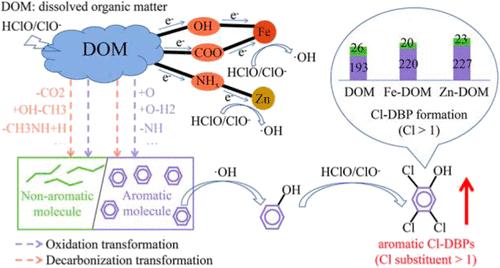当前位置:
X-MOL 学术
›
Environ. Sci. Technol.
›
论文详情
Our official English website, www.x-mol.net, welcomes your feedback! (Note: you will need to create a separate account there.)
Complexation with Metal Ions Affects Chlorination Reactivity of Dissolved Organic Matter: Structural Reactomics of Emerging Disinfection Byproducts
Environmental Science & Technology ( IF 10.8 ) Pub Date : 2024-07-23 , DOI: 10.1021/acs.est.4c03022 Qian Hu 1, 2 , Mingxuan Lou 1, 2 , Ruigang Wang 1, 2 , Sai Bai 1, 2 , He Guo 3 , Jian Zhou 1, 2 , Qiuling Ma 1, 2 , Tiecheng Wang 1, 2 , Lingyan Zhu 4 , Xiangru Zhang 5
Environmental Science & Technology ( IF 10.8 ) Pub Date : 2024-07-23 , DOI: 10.1021/acs.est.4c03022 Qian Hu 1, 2 , Mingxuan Lou 1, 2 , Ruigang Wang 1, 2 , Sai Bai 1, 2 , He Guo 3 , Jian Zhou 1, 2 , Qiuling Ma 1, 2 , Tiecheng Wang 1, 2 , Lingyan Zhu 4 , Xiangru Zhang 5
Affiliation

|
Metal ions are liable to form metal–dissolved organic matter [dissolved organic matter (DOM)] complexes, changing the chemistry and chlorine reactivity of DOM. Herein, the impacts of iron and zinc ions (Fe3+ and Zn2+) on the formation of unknown chlorinated disinfection byproducts (Cl-DBPs) were investigated in a chlorination system. Fe3+ preferentially complexed with hydroxyl and carboxyl functional groups, while Zn2+ favored the amine functional groups in DOM. As a consequence, electron-rich reaction centers were created by the C–O–metal bonding bridge, which facilitated the electrophilic attack of α-C in metal–DOM complexes. Size-reactivity continuum networks were constructed in the chlorination system, revealing that highly aromatic small molecules were generated during the oxidation and decarbonization of metal–DOM complexes. Molecular transformation related to C-R (R represents complex sites) loss was promoted via metal complexation, including decarboxylation and deamination. Consequently, complexation with Fe3+ and Zn2+ promoted hydroxylation by the C–O–metal bonding bridge, thereby increasing the abundances of unknown polychlorinated Cl-DBPs by 9.6 and 14.2%, respectively. The study provides new insights into the regulation of DOM chemistry and chlorine reactivity by metal ions in chlorination systems, emphasizing that metals increase the potential health risks of drinking water and more scientific control standards for metals are needed.
中文翻译:

与金属离子的络合影响溶解有机物的氯化反应性:新兴消毒副产物的结构反应组学
金属离子容易形成金属溶解有机物[溶解有机物(DOM)]络合物,改变DOM的化学性质和氯反应性。在此,研究了氯化系统中铁离子和锌离子(Fe 3+ 和 Zn 2+ )对未知氯化消毒副产物(Cl-DBP)形成的影响。 Fe 3+ 优先与羟基和羧基官能团络合,而 Zn 2+ 有利于与 DOM 中的胺官能团络合。结果,C-O-金属键桥产生了富电子反应中心,促进了金属-DOM复合物中α-C的亲电子攻击。在氯化系统中构建了尺寸反应连续体网络,揭示了金属-DOM配合物的氧化和脱碳过程中产生了高度芳香族的小分子。与C-R(R代表复合位点)损失相关的分子转化是通过金属络合促进的,包括脱羧和脱氨。因此,与 Fe 3+ 和 Zn 2+ 的络合促进了 C-O-金属键桥的羟基化,从而使未知多氯化 Cl-DBP 的丰度分别增加了 9.6% 和 14.2% 。该研究为氯化系统中金属离子对DOM化学和氯反应性的调节提供了新的见解,强调金属增加了饮用水的潜在健康风险,需要更科学的金属控制标准。
更新日期:2024-07-23
中文翻译:

与金属离子的络合影响溶解有机物的氯化反应性:新兴消毒副产物的结构反应组学
金属离子容易形成金属溶解有机物[溶解有机物(DOM)]络合物,改变DOM的化学性质和氯反应性。在此,研究了氯化系统中铁离子和锌离子(Fe 3+ 和 Zn 2+ )对未知氯化消毒副产物(Cl-DBP)形成的影响。 Fe 3+ 优先与羟基和羧基官能团络合,而 Zn 2+ 有利于与 DOM 中的胺官能团络合。结果,C-O-金属键桥产生了富电子反应中心,促进了金属-DOM复合物中α-C的亲电子攻击。在氯化系统中构建了尺寸反应连续体网络,揭示了金属-DOM配合物的氧化和脱碳过程中产生了高度芳香族的小分子。与C-R(R代表复合位点)损失相关的分子转化是通过金属络合促进的,包括脱羧和脱氨。因此,与 Fe 3+ 和 Zn 2+ 的络合促进了 C-O-金属键桥的羟基化,从而使未知多氯化 Cl-DBP 的丰度分别增加了 9.6% 和 14.2% 。该研究为氯化系统中金属离子对DOM化学和氯反应性的调节提供了新的见解,强调金属增加了饮用水的潜在健康风险,需要更科学的金属控制标准。












































 京公网安备 11010802027423号
京公网安备 11010802027423号